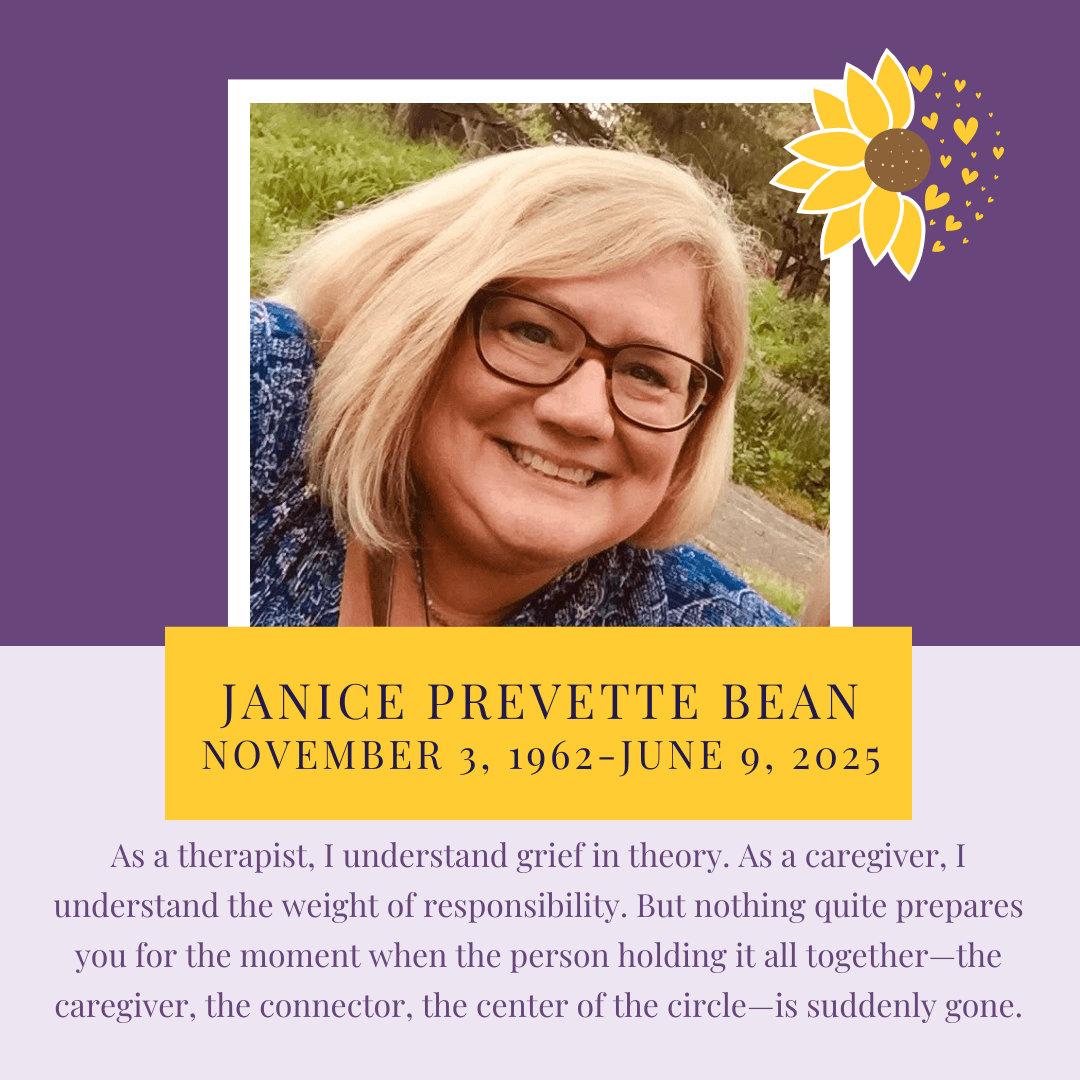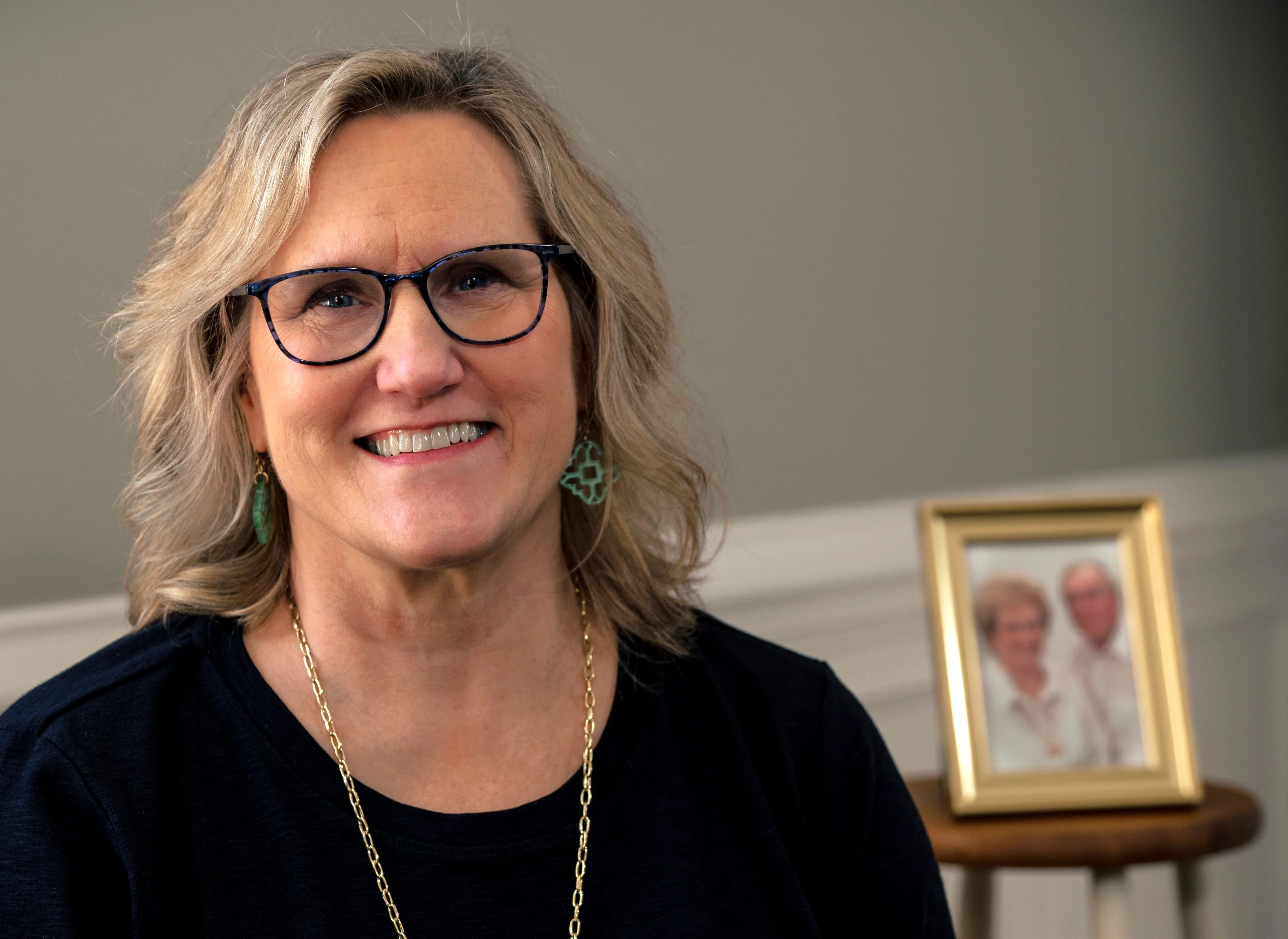Are you in North Carolina and looking for individual therapy or parent counseling?
Visit Flip Consulting and Counseling to schedule a free consultation
Written By Edla Prevette
Losing the Primary Caregiver: Navigating Grief, Shock, and What Comes Next
My sister-in-law, Janice, died unexpectedly.
She was 62. She was the primary caregiver for her husband, who has ALS, and for her 98-year-old mother, who still lives at home. Just weeks ago, she was diagnosed with a serious lung disease. It slowed her down, but not enough to stop her from doing what she had always done—taking care of everyone else.
And now, she’s gone. The shock is sitting heavy on my heart.
As a therapist, I understand grief in theory. As a caregiver, I understand the crushing weight of responsibility. But nothing quite prepares you for the moment when the person holding it all together—the caregiver, the connector, the center of the circle—is suddenly gone.
She Kept Things Steady
Janice didn’t need a spotlight. She just showed up—calm, steady, reliable. She managed her career, her husband’s care, and her mother’s needs with a kind of quiet strength that made it all seem doable.
She was generous with her time, always put her family first, and somehow still found room to laugh and enjoy life. She loved a good Hallmark movie and everything it stood for—hope, love, family, and things working out in the end.
She maintained a sense of balance that made complex responsibilities appear manageable. In her absence, the ripple effects are significant—emotionally and structurally.
Grief is surfacing not only in response to her loss, but also in the disruption of roles, routines, and relational dynamics that were anchored by her presence.
We’re not just mourning her—we’re navigating the shift her absence has created in the entire caregiving system.
The Circles of Grief—and the Ripple Effect on the Caregiving System
Right now, I feel like I’m standing in the center of several concentric circles of grief—not just for the loss of a person, but for the collapse of a caregiving system that quietly depended on her.
I’m grieving for her husband and mother—who didn’t just lose a loved one, they lost their primary caregiver, their advocate, their emotional and physical support system.
I’m grieving for her adult children and daughter-in-law—whose roles have now shifted in an instant, while they’re still trying to process their own personal loss.
I’m grieving for her future grandchildren—who will grow up hearing stories of the woman who would have adored them.
And I’m grieving for our entire family—that miss her but are now stepping in to reorganize the structure she once maintained. There are new schedules to coordinate, legal and financial logistics to manage, and conversations we never imagined we’d need to have so soon.
The grief isn’t just emotional—it’s logistical, relational, and systemic. Her absence has exposed how interconnected we all were to the care she provided, and how unprepared we were for it to end.
And then, there’s the anticipatory grief for what might come next. The what ifs are loud:
What if her husband’s condition declines more rapidly without her?
What if her mother doesn’t survive the emotional and physical toll of this loss?
What if the family fractures under the stress?
What if her adult children carry this loss with them in ways we can’t yet see?
What if we repeat the same patterns—overburdening the next caregiver until they, too, break down?
It’s overwhelming. It’s sobering. It’s grief layered on top of overwhelm, fear, and unanswered questions.

When the Caregiver Is Gone: The Silent Crisis
We don’t talk enough about what happens when a caregiver dies especially when it’s sudden. The emotional exhaustion, physical strain, and mental toll of caregiving are real health risks. And yet, too many caregivers push through it all in silence.
Studies show that caregivers are at increased risk for chronic illness, depression, anxiety, and even premature death. In fact, research from the Family Caregiver Alliance reports that 17% of caregivers rate their own health as poor—more than double the rate of non-caregivers.
Caregivers providing high-intensity care are also more likely to experience stress-related illnesses, and older spousal caregivers have a 63% higher mortality rate than non-caregivers of the same age group.
Most of us don’t recognize these red flags until it’s too late.
When the caregiver is gone, it’s not just an emotional loss. It’s a functional crisis. Roles shift. Routines collapse. And families scramble to fill a gap they didn’t prepare for.
But this isn’t just about one family. This is a wider caregiving crisis—and one we need to start naming, planning for, and supporting more actively.
So Now What? A Call to Caregivers and the Families Who Love Them
There are no tidy answers. No checklist that can make the grief disappear or solve the logistical puzzle of caregiving overnight.
But there are conversations we must start having. And there are steps we can take—now, not later.
Here’s what I want every caregiver, and every family member of a caregiver, to hear:
Don’t wait to get help-Do ask for and accept help
Caregiving is not meant to be a one-person job. Ask for help. Accept help. Share the load before it becomes too much.Don’t wait to make a plan-Do start the hard conversations now
Have uncomfortable but necessary conversations about long-term care, finances, legal documents, and emergency scenarios.Don’t ignore your symptoms-Do take your health seriously
Caregiver burnout is not just emotional—it’s physical. See your doctor. Schedule the screening. Take the fatigue seriously.Don’t assume you have more time-Do put your plans on paper
The truth is, we often don’t. Make the calls, fill out the forms, write the instructions. Give your loved ones the gift of clarity if something happens to you.Don’t be invisible-Do prioritize your own well-being
If you’re a caregiver, your needs matter just as much as the ones you care for. Prioritize rest, connection, and your own emotional well-being.
And to the rest of the family—Don’t just check in-Do step in.
If you’re not the primary caregiver but love someone who is, find small, consistent ways to share the load. Don’t wait until a crisis forces your hand.
Caregiving can be an act of deep love—but without clear boundaries, it can also become a path to burnout, resentment, and health breakdowns.
The reality is, you can’t sustain care for others if you're constantly running on empty yourself.
Boundaries aren’t selfish—they’re essential.
They protect your energy, preserve your health, and create space for you to show up fully, without losing yourself in the process.
If you're not sure where to start, I’ve created a free Boundaries Guide to help caregivers like you set limits that support both your loved ones and your own well-being. Download it here.
You won’t always get it right. None of us do. But this isn’t about being strong all the time—it’s about being honest. About what you can do, what you can’t, and what you need to keep going without burning out.
If you can step back, ask for help, and protect your own health, caregiving can become something sustainable—not just something you survive.
Join the Conversation:
Join the One-Eighty Facebook group for Sandwich Generation Adults – Find community, resources, and encouragement from people who truly get it: One-Eighty When the Parental Roles Reverse
You're Not Alone
Whether you’ve been caregiving for two months or twenty years, one thing is true: you’re doing one of the hardest jobs in the world. And you deserve support, care, and recognition—not just one day but everyday.
But for now? Start here. One strategy. One choice. One act of kindness—for yourself.
➡️Need more 1:1 support don’t hesitate to reach out to me at edla@edlaprevette.com

NOTE: It's important to remember that aging is a highly individualized process, and the timing and progression of these stages can vary among individuals. Additionally, lifestyle factors, genetics, and overall health play significant roles in how individuals experience aging.
This information is for educational purposes only and is not intended to serve as medical, psychological, or legal advice. Always consult with a qualified healthcare provider or licensed professional for guidance specific to your individual situation.

2024 Edla Prevette | www.edlaprevette.com | Privacy Policy | Terms and Conditions | Affiliate Disclosure

